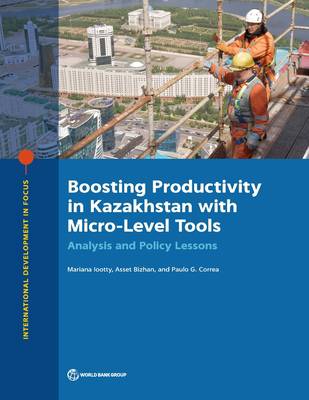
- Afhalen na 1 uur in een winkel met voorraad
- Gratis thuislevering in België vanaf € 30
- Ruim aanbod met 7 miljoen producten
- Afhalen na 1 uur in een winkel met voorraad
- Gratis thuislevering in België vanaf € 30
- Ruim aanbod met 7 miljoen producten
Zoeken
Boosting Productivity in Kazakhstan with Micro-Level Tools
Analysis and Policy Lessons
Mariana Iootty, Asset Bizhan, Paulo Correa
€ 51,95
+ 103 punten
Omschrijving
Like many other countries, Kazakhstan's economic growth has slowed since the 2007-09 global financial crisis. Although the slowdown reflected weaknesses in expanding labor and capital, the most striking reduction has been in productivity growth. In more recent years, total factor productivity growth has started to bounce back, albeit at a modest pace, possibly driven by the recovery in commodity prices. Although slower expansion in productivity has been a global phenomenon, Kazakhstan's subdued productivity performance for a decade reflects more structural problems. Against this backdrop, Boosting Productivity in Kazakhstan with Micro-Level Tools: Analysis and Policy Lessons examines barriers and policy gaps that hinder productivity growth in Kazakhstan. The detailed analysis is uniquely based on first-time access to administrative firm-level data; the data for the period of 2009-18 covered 70,000 business establishments annually, corresponding to total employment of 1.6 million people. The unprecedented access to firm-level data deepened the understanding of the microeconomic dynamics and drivers of aggregate productivity growth and enabled identification of a wide-ranging set of policy recommendations to boost aggregate productivity growth.
Specificaties
Betrokkenen
- Auteur(s):
- Uitgeverij:
Inhoud
- Aantal bladzijden:
- 82
- Taal:
- Engels
- Reeks:
Eigenschappen
- Productcode (EAN):
- 9781464819100
- Verschijningsdatum:
- 17/02/2023
- Uitvoering:
- Paperback
- Formaat:
- Trade paperback (VS)
- Afmetingen:
- 216 mm x 279 mm
- Gewicht:
- 290 g

Alleen bij Standaard Boekhandel
+ 103 punten op je klantenkaart van Standaard Boekhandel
Beoordelingen
We publiceren alleen reviews die voldoen aan de voorwaarden voor reviews. Bekijk onze voorwaarden voor reviews.








